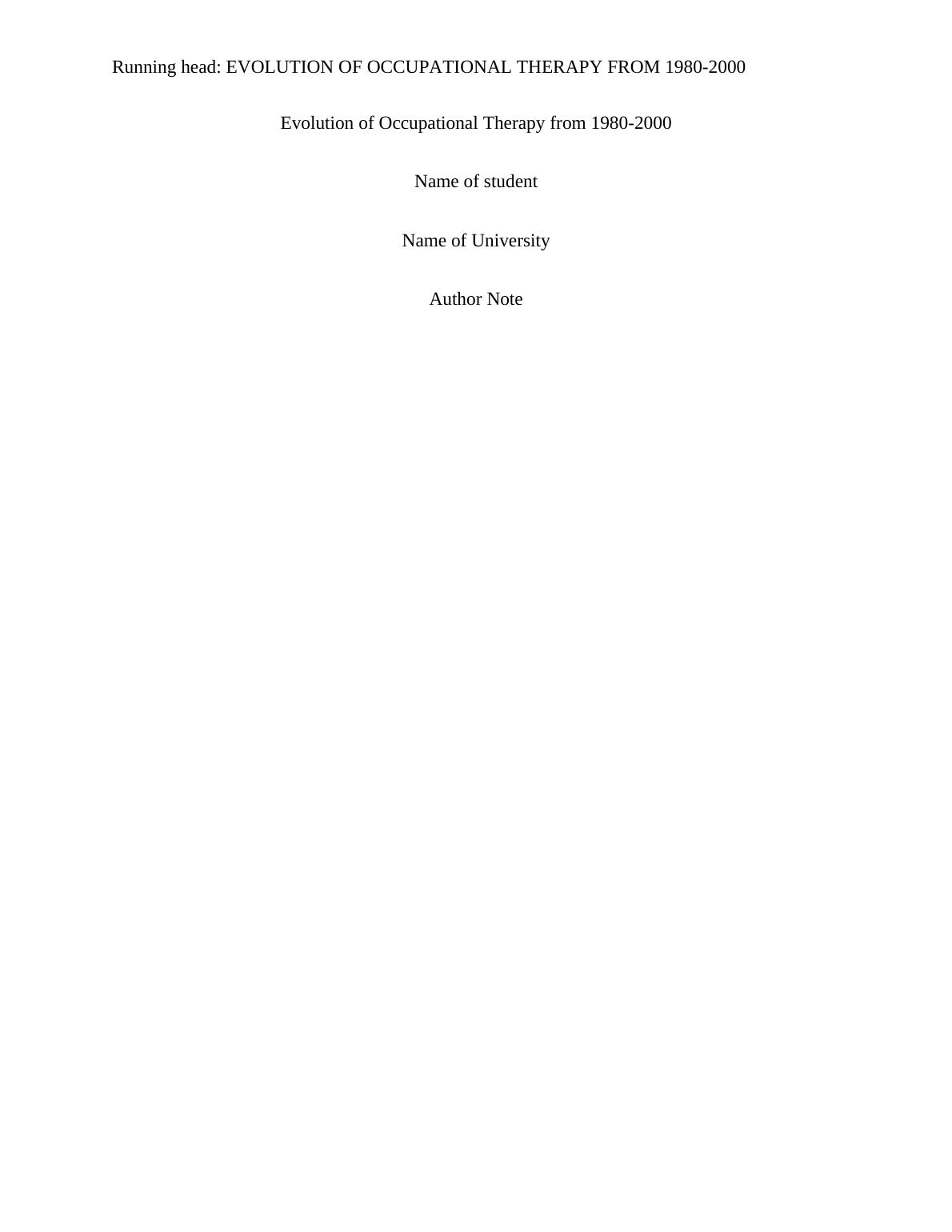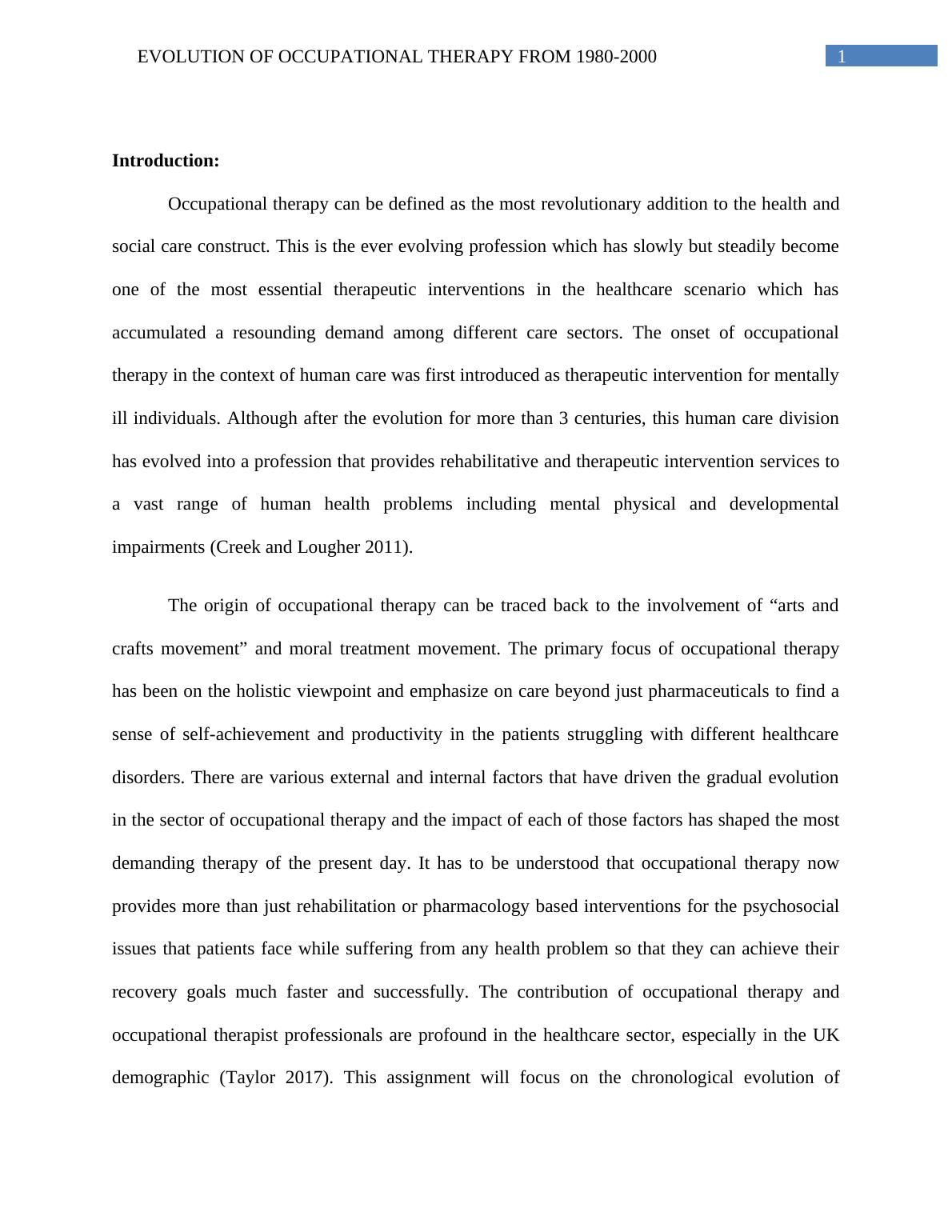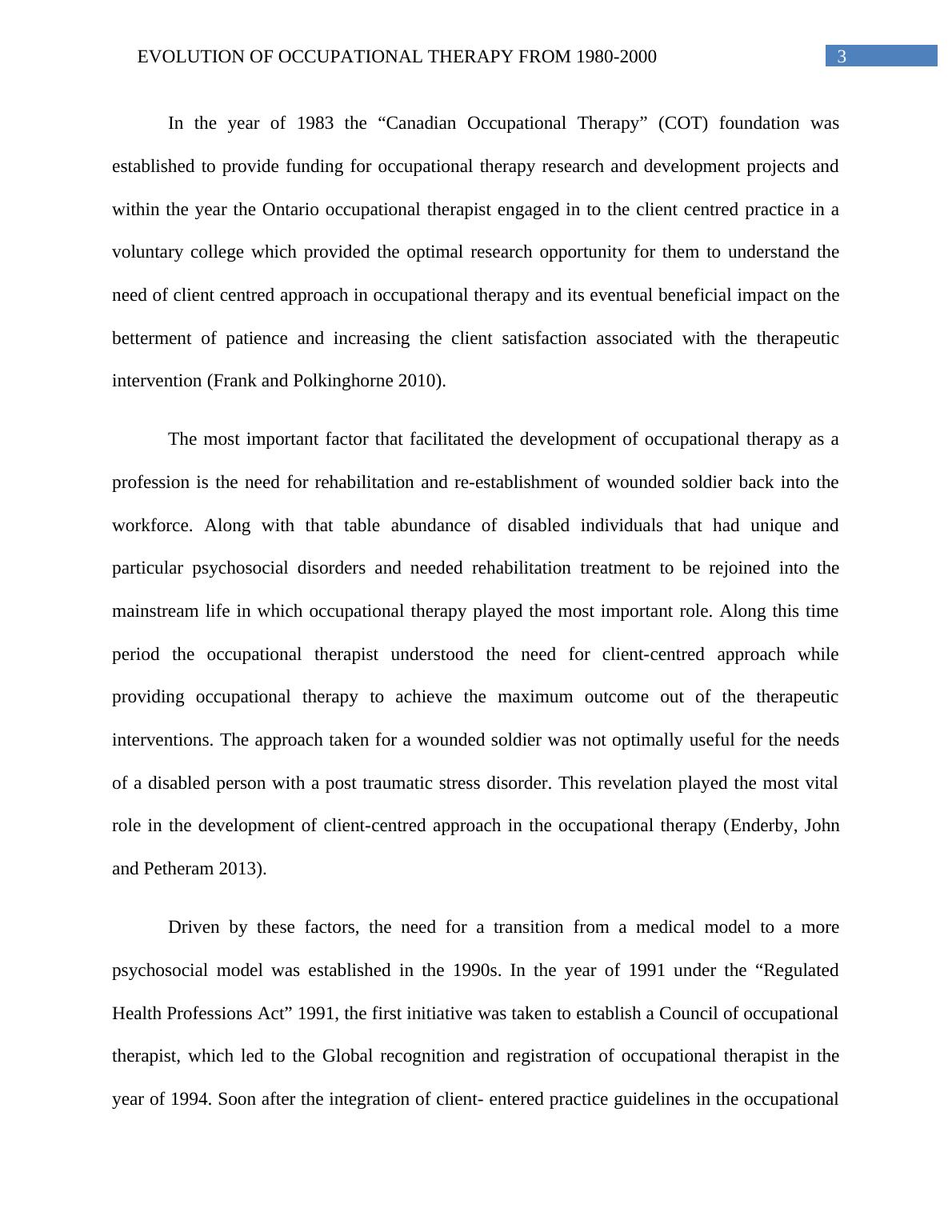Evolution of Occupational Therapy From 1980 to 2000
Added on 2021-04-21
13 Pages3432 Words213 Views
Running head: EVOLUTION OF OCCUPATIONAL THERAPY FROM 1980-2000Evolution of Occupational Therapy from 1980-2000Name of studentName of UniversityAuthor Note

1EVOLUTION OF OCCUPATIONAL THERAPY FROM 1980-2000Introduction:Occupational therapy can be defined as the most revolutionary addition to the health andsocial care construct. This is the ever evolving profession which has slowly but steadily becomeone of the most essential therapeutic interventions in the healthcare scenario which hasaccumulated a resounding demand among different care sectors. The onset of occupationaltherapy in the context of human care was first introduced as therapeutic intervention for mentallyill individuals. Although after the evolution for more than 3 centuries, this human care divisionhas evolved into a profession that provides rehabilitative and therapeutic intervention services toa vast range of human health problems including mental physical and developmentalimpairments (Creek and Lougher 2011). The origin of occupational therapy can be traced back to the involvement of “arts andcrafts movement” and moral treatment movement. The primary focus of occupational therapyhas been on the holistic viewpoint and emphasize on care beyond just pharmaceuticals to find asense of self-achievement and productivity in the patients struggling with different healthcaredisorders. There are various external and internal factors that have driven the gradual evolutionin the sector of occupational therapy and the impact of each of those factors has shaped the mostdemanding therapy of the present day. It has to be understood that occupational therapy nowprovides more than just rehabilitation or pharmacology based interventions for the psychosocialissues that patients face while suffering from any health problem so that they can achieve theirrecovery goals much faster and successfully. The contribution of occupational therapy andoccupational therapist professionals are profound in the healthcare sector, especially in the UKdemographic (Taylor 2017). This assignment will focus on the chronological evolution of

2EVOLUTION OF OCCUPATIONAL THERAPY FROM 1980-2000occupational therapy in the United Kingdom based on the different factors that has driven thechange emphasizing on the time frame of 1980 to 2000.Evolution of client-centred practice in OT: The most important innovation which can be considered a major milestone in theevolution of occupational therapy in the health and social care sector can be the incorporation ofclient centred practice principles and protocols in the context of the therapeutic interventionservice. In any case scenario client-centred approach has been given the most emphasis in thepresent day health care as well, due to the specific and specialized care intervention that helpsthe patients or care receivers most optimally. The onset of client-centred therapy in occupationaltherapy can be traced back to the 1980s. There have been many factors that have contributed tothe development of “client-centred practice” of occupational therapy and the interventions thatfocus on client-centred occupational therapy provisions. It has to be mentioned that outcomemeasurement in occupational therapy was integrated with client satisfaction and clientpreference-centred provision in the world occupational therapy scenario by the pioneersCanadian occupational therapy foundation or COTF. It has to be understood in this context that1980 to 1990 marks the historical calamity, world war, and various endemic diseases which hada severe impact on the psychosocial health of different patients. The aftermath of the first andSecond World War resulted in a vast shortage of manpower all over the world with a merit ofdifferent individuals with severe posttraumatic stress disorders and psychosocial issues thatdriven them towards social isolation and withdrawal (Duncan 2011). Along this time period theestablishment of world Federation of occupational therapist in the United Kingdom had been thestepping stone which had been further validated by the COTF in the following years

3EVOLUTION OF OCCUPATIONAL THERAPY FROM 1980-2000In the year of 1983 the “Canadian Occupational Therapy” (COT) foundation wasestablished to provide funding for occupational therapy research and development projects andwithin the year the Ontario occupational therapist engaged in to the client centred practice in avoluntary college which provided the optimal research opportunity for them to understand theneed of client centred approach in occupational therapy and its eventual beneficial impact on thebetterment of patience and increasing the client satisfaction associated with the therapeuticintervention (Frank and Polkinghorne 2010).The most important factor that facilitated the development of occupational therapy as aprofession is the need for rehabilitation and re-establishment of wounded soldier back into theworkforce. Along with that table abundance of disabled individuals that had unique andparticular psychosocial disorders and needed rehabilitation treatment to be rejoined into themainstream life in which occupational therapy played the most important role. Along this timeperiod the occupational therapist understood the need for client-centred approach whileproviding occupational therapy to achieve the maximum outcome out of the therapeuticinterventions. The approach taken for a wounded soldier was not optimally useful for the needsof a disabled person with a post traumatic stress disorder. This revelation played the most vitalrole in the development of client-centred approach in the occupational therapy (Enderby, Johnand Petheram 2013). Driven by these factors, the need for a transition from a medical model to a morepsychosocial model was established in the 1990s. In the year of 1991 under the “RegulatedHealth Professions Act” 1991, the first initiative was taken to establish a Council of occupationaltherapist, which led to the Global recognition and registration of occupational therapist in theyear of 1994. Soon after the integration of client- entered practice guidelines in the occupational

End of preview
Want to access all the pages? Upload your documents or become a member.
Related Documents
Occupational Health & Wellbeing - Assignmentlg...
|8
|2265
|80
Professional Pathways in Health Sciencelg...
|12
|2914
|63
Leadership in Occupational Therapylg...
|5
|907
|374
Evolution of Nursing Roles and Responsibilities in the US Healthcare Systemlg...
|6
|1657
|410
System Perspective of Liverpool Hospital in Providing Physiotherapy Services to Patientslg...
|22
|2132
|474
Implementation Of Consent In Treatmentlg...
|8
|1593
|8
